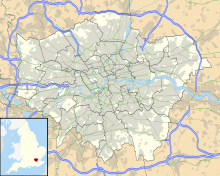RAF Biggin Hill
|
London Biggin Hill Airport Biggin Hill Airport |
|||||||||||||||
|---|---|---|---|---|---|---|---|---|---|---|---|---|---|---|---|
 |
|||||||||||||||
 |
|||||||||||||||
| Summary | |||||||||||||||
| Airport type | Public | ||||||||||||||
| Operator | Regional Airports Ltd. | ||||||||||||||
| Location | Bromley, Greater London | ||||||||||||||
| Elevation AMSL | 599 ft / 183 m | ||||||||||||||
| Coordinates | 51°19′51″N 000°01′57″E / 51.33083°N 0.03250°ECoordinates: 51°19′51″N 000°01′57″E / 51.33083°N 0.03250°E | ||||||||||||||
| Website | www.bigginhillairport.com | ||||||||||||||
| Map | |||||||||||||||
| Location in Greater London | |||||||||||||||
| Runways | |||||||||||||||
|
|||||||||||||||
| Statistics (2012) | |||||||||||||||
|
|||||||||||||||
| Movements | 49,830 |
|---|
London Biggin Hill Airport (IATA: BQH, ICAO: EGKB) is an operational general aviation airport at Biggin Hill in the London Borough of Bromley, located 12 NM (22 km; 14 mi) south-southeast of Central London. The airport was formerly the Royal Air Force station RAF Biggin Hill, and a small enclave on the airport still retains that designation.
Biggin Hill is best known for its role during the Battle of Britain in the Second World War, when it served as one of the principal fighter bases protecting London and South East England from attack by enemy bombers. Over the course of the war, fighters based at Biggin Hill claimed 1,400 enemy aircraft, at the cost of the lives of 453 Biggin Hill based aircrew.
The airport has a CAA Ordinary Licence (Number P804) that allows flights for the public transport of passengers or for flying instruction as authorised by the licensee (Regional Airports Limited). It specialises in general aviation, handling a spectrum of traffic from private aviation to large business jets. It currently has no scheduled airline service, as flights using the airport are not permitted to carry fare-paying passengers.
The airfield was originally opened by the Royal Flying Corps (RFC) during the First World War. At first in 1916 Koonowla House was requisitioned by the War Office in 1916, for the RFC to conduct wireless experiments. Then on 13 Feb 1917 the RFC transferred there (from their long time HQ at RAF Joyce Green, Dartford, and established it as part of the London Air Defence Area, using the adjacent Cudham Lodge estate which contained a huge undivided field, ideal for aircraft. The station was responsible for defending the capital against attacks by Zeppelins and Gotha bombers. To this end, 141 Squadron of the RFC was based at Biggin Hill and equipped with Bristol Fighters.
...
Wikipedia

